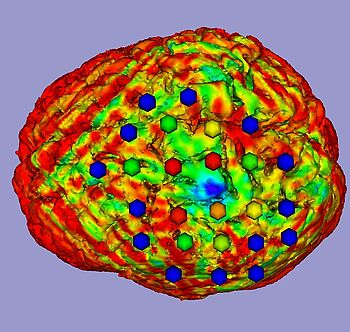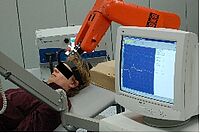Transcranial Magnetic Stimulation (TMS)
Project Description
Aim of the project is to develop a robot assistance system for delivering TMS. Furthermore, we work on a statistical brain mapping procedure to localise muscle representations in the cortex.
The advantages of robotised TMS are manifold:
- Precise targeting of stimulation points.
- Precise tangential orientation of the stimulation coil.
- Simple planning and fast probing of grid-like stimulation patterns.
- Motion compensation keeps coil in place even if the patient moves. A fixation of the head is not necessary any more.
- Repeatability.
For the brain mapping algorithm we combine all three essential pieces of information: The coil positions for stimulation, the corresponding muscle responses, and the characteristic field of the coil used. The main idea is to assume a monotonic functional relation between the electric field strength at the representation point and the evoked muscle response. Using a refined algorithm for Correlation Ratio and Kendall's rank coefficient TAU, we are able to calculate likelihood maps for the representation of specific muscles.

Publications
2010
Towards Direct Head Navigation for robot-guided Transcranial Magnetic Stimulation using 3D Laserscans: Idea, Setup and Feasibility, Armentano, Ricardo and Hudson, Donna and Monzon, Jorge and Patton, Jim, Eds. Buenos Aires, Argentina , 2010. pp. 2283-2286.
| DOI: | 10.1109/IEMBS.2010.5627660 |
| ISBN: | 978-1-4244-4124-2 |
| File: | IEMBS.2010.5627660 |
2009
Anwendung der FaceAPI zur Bewegungskompensation für die robotergestützte Transkranielle Magnetstimulation, 2009.
Behandlung von chronischem Tinnitus mit roboterunterstützter TMS, Lübeck: GI, 2009. pp. 86;1018-1027.
Robotized image-guided transcranial magnetic stimulation, a novel technique for functional brain-mapping, Clinical Neurophysiology , vol. 120, no. 1, pp. e84, 2009.
| DOI: | 10.1016/j.clinph.2008.07.203 |
| File: | j.clinph.2008.07.203 |
2008
A robotic assistance system for transcranial magnetic stimulation and its application to motor cortex mapping, 2008.
Brain mapping with Transcranial Magnetic Stimulation using a refined Correlation Ratio and Kendall's tau, Statistics in Medicine , vol. 27, no. 25, pp. 5252-5270, 2008.
| DOI: | 10.1002/sim.3353 |
| File: | sim.3353 |
Brain-Mapping using robotized TMS, Vancouver, British Columbia, Canada , 2008. pp. 3929-3932.
Comparison of functional brain mapping by computer controled roboterized transcranial-magnet-stimulation and functional MRI, Würzburg , 2008.
2007
Spulenpositionierung bei TMS-Behandlungen mit Hilfe von Kraftsensorik, 2007.
2006
Planning and analyzing robotized TMS using virtual reality., Studies in Health Technology and Informatics , vol. 119, pp. 373-378, 2006.
Robotized TMS for motion compensated navigated brain stimulation, Osaka, Japan , 2006.
Solving the positioning problem in TMS, GMS CURAC , vol. 1, 2006.
2005
Brainmapping With TMS Using A Robot Based Protocol And Image Registration Techniques, Berlin: VDI-Verlag, 2005. pp. 23.

- Research
- Robotics Laboratory (RobLab)
- OLRIM
- MIRANA
- Robotik auf der digitalen Weide
- KRIBL
- Ultrasound Guided Radiation Therapy
- Digitaler Superzwilling: Projekt TWIN-WIN
- - Finished Projects -
- High-Accuracy Head Tracking
- Neurological Modelling
- Modelling of Cardiac Motion
- Motion Compensation in Radiotherapy
- Navigation and Visualisation in Endovascular Aortic Repair (Nav EVAR)
- Autonome Elektrofahrzeuge als urbane Lieferanten
- Goal-based Open ended Autonomous Learning
- Transcranial Electrical Stimulation
- Treatment Planning
- Transcranial Magnetic Stimulation
- Navigation in Liver Surgery
- Stereotactic Micronavigation
- Surgical Microscope
- Interactive C-Arm
- OCT-based Neuro-Imaging
Achim Schweikard

Gebäude 64
,
Raum 94
achim.schweikard(at)uni-luebeck.de
+49 451 31015200
Floris Ernst

Gebäude 64
,
Raum 97
floris.ernst(at)uni-luebeck.de
+49 451 31015208
Ehemalige Projektmitarbeiter
- Dr. Ing. Fernando Gasca
- Dr.-Ing. Lars Richter
- Dr.-Ing. Lars Matthäus

